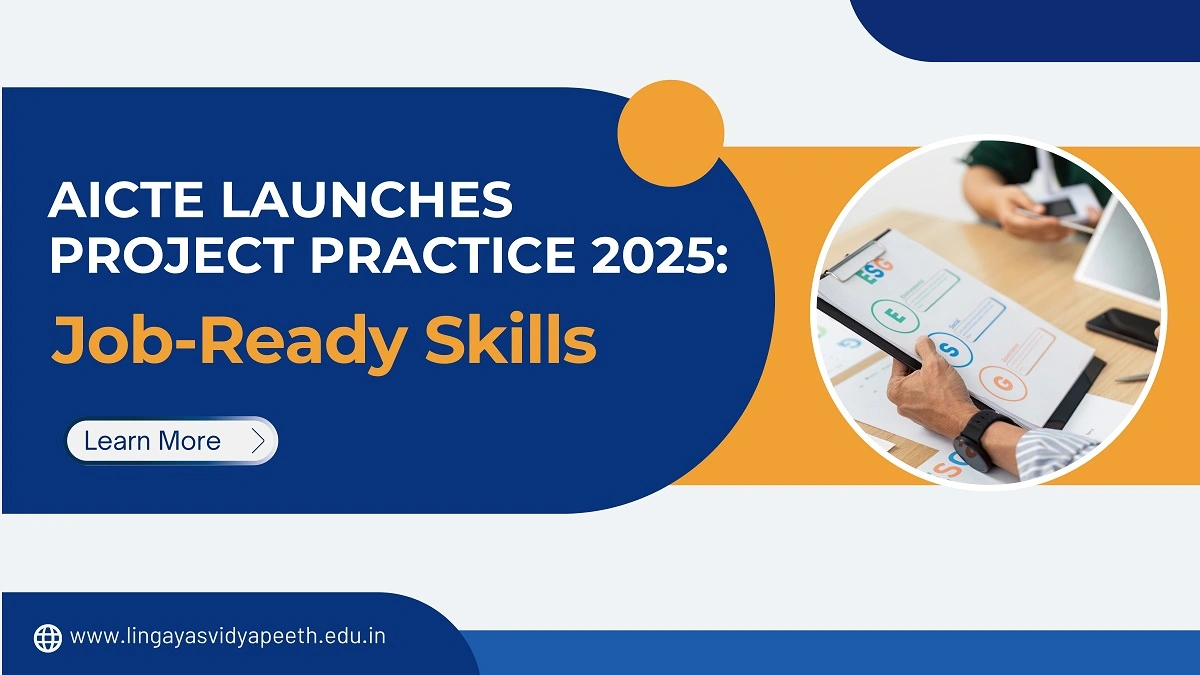Home » AICTE Launches Project PRACTICE 2025 to Build Job-Ready Skills

Engineering students across India just got some exciting news. The All India Council for Technical Education (AICTE) has rolled out a massive skill-building push. On September 15, 2025, Engineers’ Day, AICTE announced Project PRACTICE—a bold plan to reshape how technical education works in India.
This initiative is not about rote learning or memorizing theories. Instead, it focuses on hands-on projects, industry exposure, and real-world problem solving. The goal? To make 20 lakh students job-ready over the next three years. If you are an engineering student, this could be a game-changer for your career.
Let’s break down what makes Project PRACTICE special and why it matters for you.
Project PRACTICE stands for Project for Advancing Critical Thinking, Industry Connect, and Employability. Quite a mouthful, right? But the idea is simple: help students learn by doing, not just by reading.
This program focuses on tier-2 and tier-3 colleges—about 1,000 institutions where students often miss out on big opportunities. Together, these colleges represent nearly 30 lakh students across 5,868 AICTE-approved institutes.
Here’s how the rollout looks:
By the end of 2027, 20 lakh students and 10,000 teachers will directly benefit. AICTE, along with partners like Maker Bhavan Foundation, LEAP, and CRISP, is investing ₹23.31 crore to make this vision real.
Imagine this: instead of writing exams based on old question papers, you and your classmates work on a live company project. You could be designing an app, fixing a factory problem, or testing a new product.
That’s what Project PRACTICE enables. The learning model shifts to project-based learning where skills like coding, design, communication, and teamwork grow naturally.
Even better, students get free access to advanced AI tools like ChatGPT and Perplexity Go. That means less time spent on repetitive tasks and more focus on creativity and problem-solving.
Think of a student from a small-town college who leads a project to improve a local factory’s production line. That achievement not only builds confidence but also becomes a strong resume point—and possibly leads to a job offer.
Teachers aren’t left out either. They receive training to guide students better, creating a healthy cycle of growth for both sides.
AICTE also launched the AICTE Research Internship (ARI) Portal along with Project PRACTICE. This platform connects students with leading research labs and companies.
Instead of searching endlessly for opportunities, students can log in, select their fields of interest—say AI, biotechnology, or renewable energy—and apply directly. Mentors guide them through real projects, making learning much more impactful.
This means thousands of students will soon access internships that actually matter. From data analytics to climate tech, the exposure gained here will make resumes stand out in competitive job markets.
The AICTE also wants students to think beyond jobs. That’s why it is making Research and Development (R&D) Cells and Climate Cells mandatory in every approved college.
By working in these cells, students don’t just learn—they also become leaders who can tackle tomorrow’s global challenges. Sustainability and innovation blend perfectly with Project PRACTICE’s vision.
This initiative is not just an idea on paper—it comes with measurable goals:
Currently, India produces about 1.5 million engineering graduates every year, but only half land the jobs they dream of. The main reason is a lack of industry-ready skills. AICTE’s move directly addresses this gap.
For students in tier-2 and tier-3 cities, this is especially impactful. These regions house nearly 60% of engineering students, yet they often lack exposure. Now, they’ll get the same chances as those in metro cities.
AICTE has also promised special focus on encouraging girls in STEM, ensuring they not only join but also lead.
The future looks bright, but it requires student participation. Here’s how you can make the most of it:
Remember, great engineers are not just exam toppers. They are problem-solvers, innovators, and leaders. With AICTE’s new initiatives, you now have the tools to step into that role.
So, what’s your first project idea? Think bold, think practical, and start building the future today.
Also Read
Information technology courses after 12th
Product management courses after 12th
Global Student Prize 2025: Bihar’s Adarsh Kumar Becomes India’s Pride
India’s First Gold in Speed Skating Worlds: Anandkumar Velkumar
RECENT POSTS
CATEGORIES
TAGS
Agriculture Agriculture future AI Architecture artificial intelligence Bachelor of Commerce BA English BA Psychology BTech AIML BTech CSE BTech cybersecurity BTech Engineering Business management career Career-Specific Education career guide career option career scope Civil engineering commerce and management Computer Science Computer science engineering Data science degree education Engineering Engineering students English Literature english program Fashion Design Fashion design course Higher Education Journalism journalism and mass communication law Law career Machine Learning mathematics MBA MBA specialization Mechanical Engineering Pharmacy Psychology Research and Development students
Nachauli, Jasana Road, Faridabad, Haryana
Address: C-72, Second Floor, Shivalik, Near Malviya Nagar,
Above HDFC Bank, New Delhi 110017
Landline No. - 011-46570515 / 45138169 / 41755703
Mobile No. - +91-7303152412 / +91-7303152420 / +91-9311321952
Toll Free: 1800-120-4613
Mobile : 8447744303 | 8447744304 | 8447744306 | 8447744309
8700003974 | 8700003411 | 8700003749
Copyrights © 1998 - 2026 Lingaya's Vidyapeeth (Deemed To Be University). All rights reserved.
LV only conducts physical/online verification of any document related to examination on the following email id:
It is important to note that the following email IDs and domains are fraudulent and do not belong to our university.